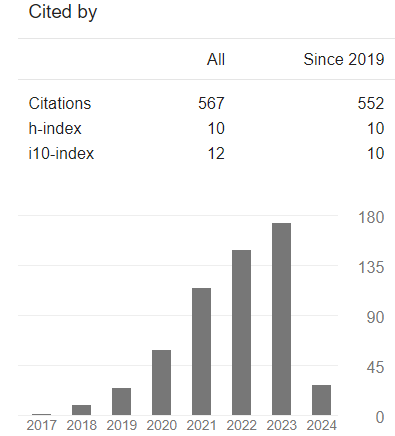Death Instinct Manifested through Passive Aggresiveness and Its Social Effects in Melville's "Bartleby the Scrivener"
DOI:
https://doi.org/10.15642/NOBEL.2017.8.1.1-8Keywords:
death instinct; passive aggresiveness; behavior; effectAbstract
Death instinct is a lifeless drive in human mind that certainly can affect behavior. This instinct can be manifested through passive aggressiveness that is not easily noticed but will slowly bring loss to everyone involved. In deeply understanding this matter, this paper attempts to analyze the death instinct manifested through passive-aggressiveness by depicting a short story entitled “Bartleby the Scrivener.†To do that, this paper will first examine Bartleby's behaviors that indicate passive aggressiveness. Furthermore, it will explore how Bartleby's passive aggressiveness affects people around him. The result of this analysis shows that Bartleby's death instinct which leads him into death is caused by his persistence to have a static life. This form of passive agrresiveness kills his social life and brings anxiety, confusion, and anger to people who interact with him.
Downloads
References
“Bartleby the Scrivener, A Tale of Wall Street.†(1998). Encyclopedia.com. Retrieved December 1, 2016 from http://www.encyclopedia.com/article-1G2-2695000013/bartleby-scrivener-tale-wall.html
Chalquist, C. (2001). “A Glossary of Freudian Terms.†RetrievedFebruary 21, 2017from http://www.terrapsych.com/freud.html
Desmarais, J. (2001, Spring). Preferring not to: The Paradox of Passive Resistance in Herman Melville’s “Bartlebyâ€.Journal of the Short Story in English, 36.Retrieved January 4, 2017 fromhttp://jsse.revues.org/index575.html
Francis, A., Pincus, H.A. & First, M.B., (1994). Diagnostic and Statistical Manual of Mental Disorders: DSM-IV (Fourth Edition). Washington: The American Psychiatric Association.
Goldson, J. (2015). How to Deal with Passive Aggressive People. Retrieved January 25, 2017 from http://www.nzherald.co.nz/lifestyle/news/article.cfm?c_id=6&objectid=11412955
Hall-Flavin, D. K. (2013). What is Passive-Aggressive Behavior? What are Some of the Signs?Retrieved February 7, 2017 from http://www.mayoclinic.org/healthy-lifestyle/adult-health/expert-answers/passive-aggressive-behavior/faq-20057901
Kelly, D. (2010). Passive-Aggressive Personality Disorder.Retrieved February 21, 2017 from http://www.ptypes.com/passive-aggpd.html
Omur, A. (n.d.).12 Ways Your Passive-Aggressiveness is Slowly Killing Your Relationships.Retrieved February 19, 2017 from http://www.lifehack.org/articles/communication/12-ways-passive-aggressiveness-slowly-killing-relationships.html
Vrticka, P. (2013). Evolution of the ‘Social Brain’ in Humans: What are the Benefits and Costs of Belonging to A Social Species? Retrieved December 16, 2016 from http://www.huffingtonpost.com/pascal-vrticka/human-social-development_b_3921942.html







